Choosing loose leaf tea is a fantastic way to embrace eco-friendly tea drinking. You'll enjoy superior flavor while reducing packaging waste. Opt for organic, fair trade teas to support sustainable farming practices and ethical labor conditions. Use reusable infusers made from stainless steel or bamboo for brewing, and compost your used leaves to enrich garden soil. Store your tea in glass jars or natural fiber pouches to avoid plastic. Consider growing your own tea plants or creating eco-friendly blends using local ingredients. By implementing these practices, you'll sip sustainably and minimize your environmental impact. Discover even more ways to green your tea routine as you explore sustainable steeping methods.
Benefits of Loose Leaf Tea
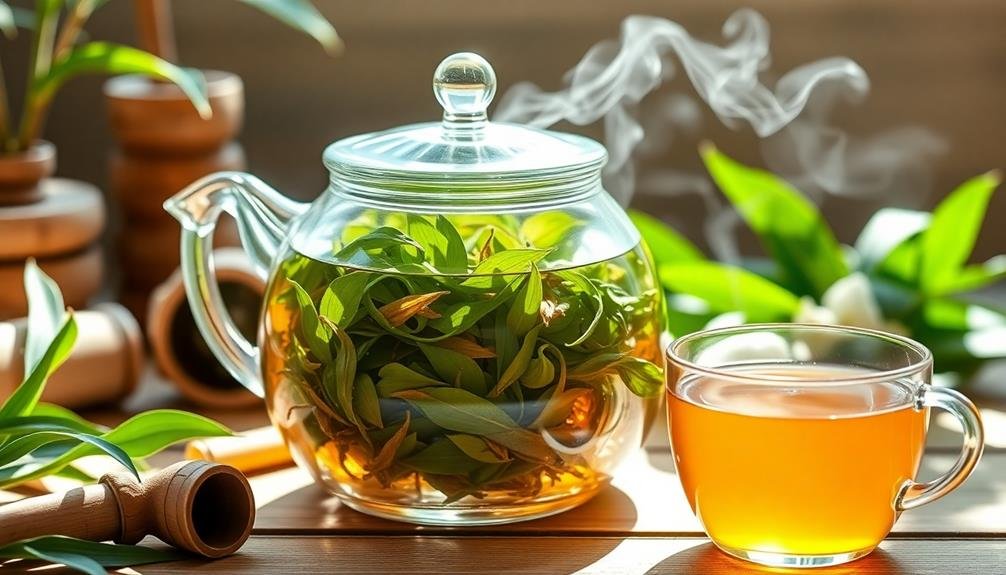
Discover the numerous advantages of choosing loose leaf tea over pre-packaged options. You'll enjoy superior flavor and aroma as loose leaves have more room to expand, releasing their full potential. The larger leaves retain more essential oils and nutrients, providing a richer taste experience and increased health benefits.
You'll have greater control over the strength of your brew by adjusting the amount of leaves used. This flexibility allows you to customize each cup to your preferences.
Loose leaf tea is often fresher, as it's not confined to tea bags that can degrade the leaves' quality over time.
By opting for loose leaf, you're making an environmentally conscious choice. There's less packaging waste compared to individually wrapped tea bags, reducing your carbon footprint. You can also compost the used leaves, further minimizing waste.
Loose leaf tea often offers better value for money. Though the initial cost may be higher, you can resteep the leaves multiple times, extracting more flavor and stretching your purchase.
You'll also find a wider variety of high-quality teas available in loose leaf form, expanding your tea-drinking horizons.
Choosing Sustainable Tea Sources
When selecting eco-friendly loose leaf tea, you'll want to take into account the sustainability of your sources.
Look for teas with organic certification, which guarantees they're grown without harmful pesticides or synthetic fertilizers.
Additionally, seek out brands that prioritize fair trade practices, making certain tea farmers receive fair wages and work in safe conditions.
Organic Certification Matters
Choosing organic certified tea isn't just about personal health; it's a powerful way to support sustainable farming practices. When you opt for organic tea, you're endorsing a system that prohibits synthetic pesticides, herbicides, and fertilizers. This commitment to natural farming methods protects soil health, preserves biodiversity, and safeguards water quality.
Look for credible organic certifications like USDA Organic, EU Organic, or JAS (Japanese Agricultural Standard). These labels guarantee the tea has been produced following strict organic guidelines. They also indicate that the tea is free from genetically modified organisms (GMOs) and hasn't been irradiated.
Organic certification extends beyond just growing practices. It covers processing, packaging, and transportation, guaranteeing the entire supply chain adheres to eco-friendly standards.
Fair Trade Practices
Beyond organic certification, it's important to take into account fair trade practices when selecting your loose leaf tea. Fair trade guarantees that tea farmers and workers receive fair wages and work in safe conditions.
When you choose fair trade tea, you're supporting sustainable farming practices and community development in tea-growing regions. Look for certifications like Fairtrade International or Fair Trade USA on tea packaging. These labels indicate that the tea meets strict social, economic, and environmental standards.
Fair trade practices often include prohibiting child labor, promoting gender equality, and investing in local education and healthcare. You can also research tea companies to find those committed to ethical sourcing.
Many transparent brands share information about their supply chains and relationships with tea growers. By supporting these companies, you're encouraging responsible business practices in the tea industry.
Reusable Tea Infusers
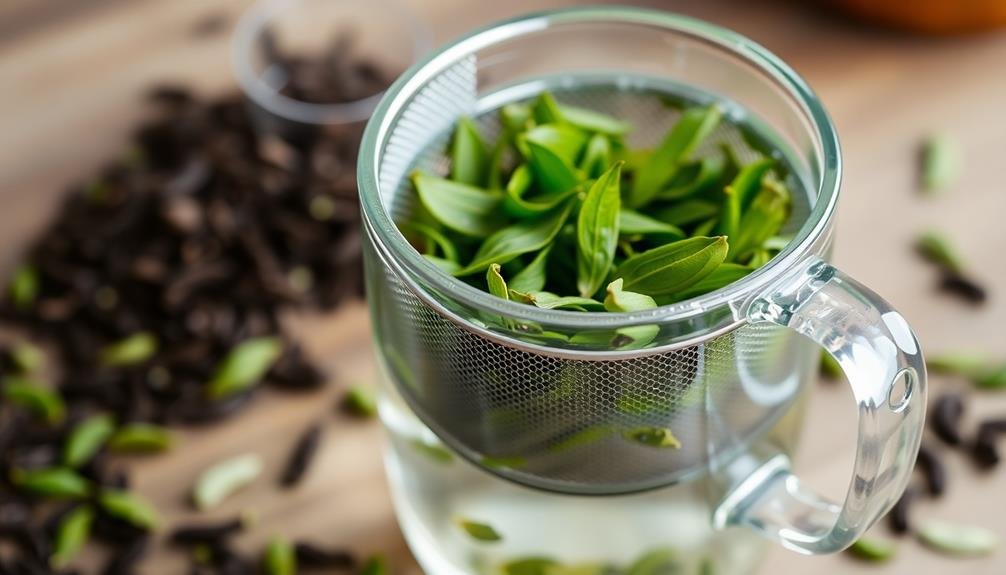
When you're ready to brew your eco-friendly loose leaf tea, you'll need to choose the right reusable infuser.
You'll find various types of infusers made from different materials, each with its own durability and environmental impact.
Understanding how to clean and maintain your infuser will guarantee it lasts longer, reducing waste and enhancing your tea-drinking experience.
Types of Infusers
To enjoy loose leaf tea sustainably, reusable tea infusers are an essential tool. They come in various types, each with its own advantages. You'll find ball infusers, which are simple and easy to use, perfect for single servings. Basket infusers offer more space for tea leaves to expand, resulting in a fuller flavor. For convenience, you might prefer stick infusers that double as stirring spoons.
If you're environmentally conscious, consider these eco-friendly options:
| Material | Pros | Cons |
|---|---|---|
| Stainless Steel | Durable, non-reactive | Can affect tea temperature |
| Silicone | Flexible, heat-resistant | May retain flavors |
| Bamboo | Biodegradable, natural | Requires more maintenance |
For larger quantities, try brewing baskets that fit inside your teapot or mug. They're ideal for sharing tea with friends. If you're always on the go, travel mugs with built-in infusers offer a portable solution. Don't forget about traditional options like cotton or linen tea bags, which you can fill with your favorite loose leaf blend. By choosing the right infuser, you'll enhance your tea experience while reducing waste.
Materials and Durability
While choosing the right type of infuser is important, the materials used in their construction play a key role in their durability and eco-friendliness.
Stainless steel infusers are a popular choice due to their longevity and resistance to rust. They're easy to clean and won't impart any flavors to your tea.
Silicone infusers offer flexibility and heat resistance but may retain odors over time.
For a more natural option, consider bamboo infusers. They're biodegradable and renewable, though they may not last as long as metal alternatives.
Glass infusers are aesthetically pleasing and won't affect tea flavor, but they're more fragile and require careful handling.
When evaluating durability, look for infusers with sturdy construction and tight-fitting lids or closures. Avoid infusers with thin metal mesh that can easily tear or warp.
Opt for products with seamless designs to prevent tea leaves from getting trapped in crevices.
To extend the life of your infuser, rinse it thoroughly after each use and allow it to dry completely.
Avoid harsh detergents that can damage the material, and consider occasional deep cleaning with baking soda or vinegar to remove stains and odors.
Cleaning and Maintenance
Proper cleaning and maintenance of reusable tea infusers are essential for guaranteeing their longevity and the purity of your tea's flavor. After each use, rinse your infuser thoroughly with hot water to remove any remaining tea leaves.
For a deeper clean, use a mild, unscented dish soap and a soft brush to gently scrub the mesh or perforations. Avoid using harsh chemicals or abrasive materials that could damage the infuser's surface.
To keep your tea infuser in top condition, follow these steps:
- Rinse immediately after use to prevent tea stains and residue buildup
- Deep clean weekly with mild soap and warm water
- Dry completely before storing to prevent mold growth
- Inspect regularly for signs of wear or damage
For stubborn stains or mineral deposits, soak your infuser in a mixture of equal parts water and white vinegar for 30 minutes. Rinse thoroughly and air dry.
If your infuser is dishwasher-safe, you can occasionally run it through a gentle cycle for convenience. However, hand washing is generally recommended to extend its lifespan.
Composting Used Tea Leaves
Composting used tea leaves is an excellent way to recycle your brewing waste and enrich your garden soil. After enjoying your cup of loose leaf tea, don't toss those spent leaves in the trash. Instead, add them to your compost bin or directly to your garden beds.
Tea leaves are rich in nitrogen, making them a valuable "green" component for your compost pile. They break down quickly and help balance the carbon-rich "brown" materials like dried leaves or paper. To compost tea leaves, simply empty your infuser into your compost bin and mix them in.
If you use paper tea bags, you can compost those too, but remove any staples or strings first.
You can also use tea leaves directly in your garden. Sprinkle them around plants as a nutrient-rich mulch or work them into the soil. They'll improve soil structure, retain moisture, and slowly release nutrients.
Tea leaves are particularly beneficial for acid-loving plants like roses, ferns, and azaleas. Just be sure to use unflavored tea leaves to avoid adding artificial ingredients to your soil.
Plastic-Free Tea Storage
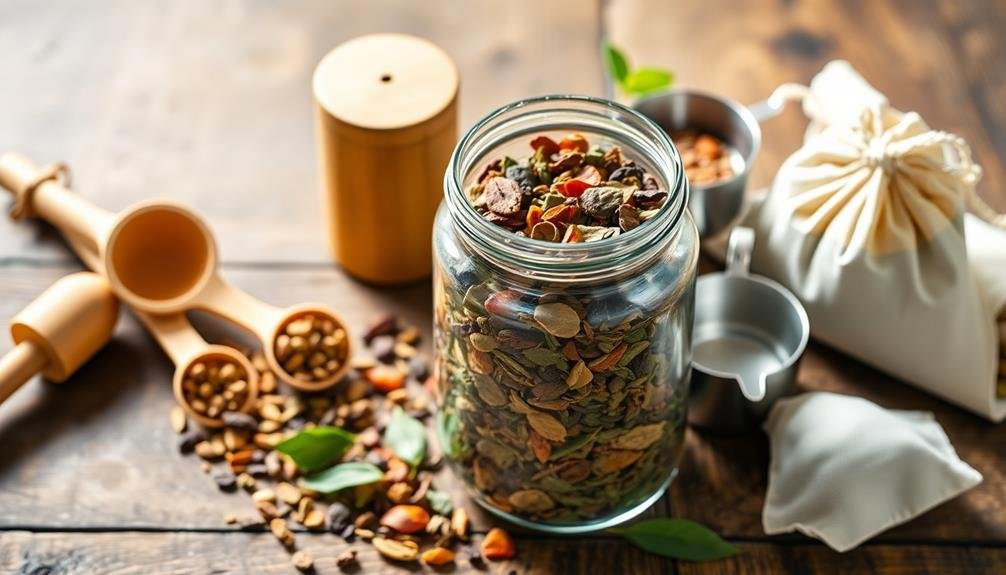
When storing your loose leaf tea, you'll want to contemplate plastic-free options to maintain your eco-friendly approach.
Glass jars and containers offer an airtight, reusable solution that keeps your tea fresh without introducing harmful plastics.
You can also explore reusable cloth tea bags for brewing and natural fiber storage pouches for a completely plastic-free tea experience.
Glass Jars and Containers
Glass jars and containers stand out as an excellent choice for storing loose leaf tea without relying on plastic. They're durable, reusable, and allow you to see the contents at a glance. When selecting glass containers for your tea, opt for those with airtight lids to maintain freshness and prevent moisture from seeping in.
You'll find a variety of sizes and shapes to suit your tea collection, from small jars for sample sizes to larger ones for bulk storage.
To make the most of your glass tea storage, consider these tips:
- Clean and dry the jars thoroughly before use
- Label each container with the tea type and purchase date
- Store in a cool, dark place to preserve flavor and aroma
- Use UV-protective amber glass for light-sensitive teas
Glass containers aren't just practical; they're also aesthetically pleasing. You can create a visually appealing tea display in your kitchen or pantry, showcasing the vibrant colors and textures of your loose leaf collection.
Reusable Cloth Tea Bags
Reusable cloth tea bags offer another eco-friendly option for storing and brewing loose leaf tea. These bags are typically made from organic cotton, muslin, or hemp, providing a natural and chemical-free alternative to disposable paper tea bags. You'll find them in various sizes, from small single-serving pouches to larger bags for brewing multiple cups.
To use cloth tea bags, simply fill them with your favorite loose leaf tea and tie or seal them securely. They're perfect for both hot and cold brewing methods, and you can easily adjust the amount of tea to suit your taste preferences.
After use, rinse the bag thoroughly and hang it to dry. You can reuse these bags multiple times before washing them in hot water.
Cloth tea bags aren't only environmentally friendly but also cost-effective in the long run. They eliminate the need for disposable filters and reduce waste associated with pre-packaged teas. Additionally, they allow the tea leaves to expand fully, resulting in a better-tasting brew.
When storing loose leaf tea in cloth bags, keep them in an airtight container to maintain freshness and prevent moisture absorption.
Natural Fiber Storage Pouches
For long-term storage of loose leaf tea, natural fiber pouches offer an excellent plastic-free alternative. These eco-friendly containers not only preserve your tea's freshness but also reduce your environmental impact. Made from materials like cotton, linen, or hemp, they're breathable, allowing your tea to stay dry and aromatic.
When choosing natural fiber storage pouches, consider these options:
- Drawstring cotton bags
- Linen tea caddies with wooden lids
- Hemp pouches with toggle closures
- Muslin sachets with ribbon ties
You'll find these pouches in various sizes, so you can store small quantities for daily use or larger amounts for bulk purchases.
To maintain your tea's quality, keep the pouches in a cool, dark place away from strong odors. You can easily label them using fabric markers or removable tags, making it simple to organize your tea collection.
When it's time to clean your pouches, just toss them in the washing machine on a gentle cycle. By switching to natural fiber storage, you're not only protecting your tea but also contributing to a more sustainable lifestyle.
Energy-Efficient Brewing Methods
When brewing your eco-friendly loose leaf tea, you'll want to contemplate energy-efficient methods that minimize your environmental impact. Start by using an electric kettle, which heats water faster and more efficiently than stovetop options. Once hot, transfer the water to a thermal carafe to maintain temperature without additional energy.
For small servings, consider using a tea infuser mug, which reduces heat loss and conserves energy. If you're brewing larger quantities, opt for a French press or teapot with good insulation. These methods retain heat longer, reducing the need for reheating.
Here's a comparison of energy consumption for different brewing methods:
| Method | Energy Use | Time to Brew |
|---|---|---|
| Electric Kettle | Low | Quick |
| Stovetop Kettle | High | Slow |
| Microwave | Medium | Moderate |
To further reduce your carbon footprint, try cold brewing. Simply steep your loose leaf tea in cold water overnight in the refrigerator. This method requires no energy for heating and produces a smooth, less bitter flavor. You can enjoy it cold or gently warm it if desired, using considerably less energy than traditional hot brewing methods.
Water Conservation Techniques
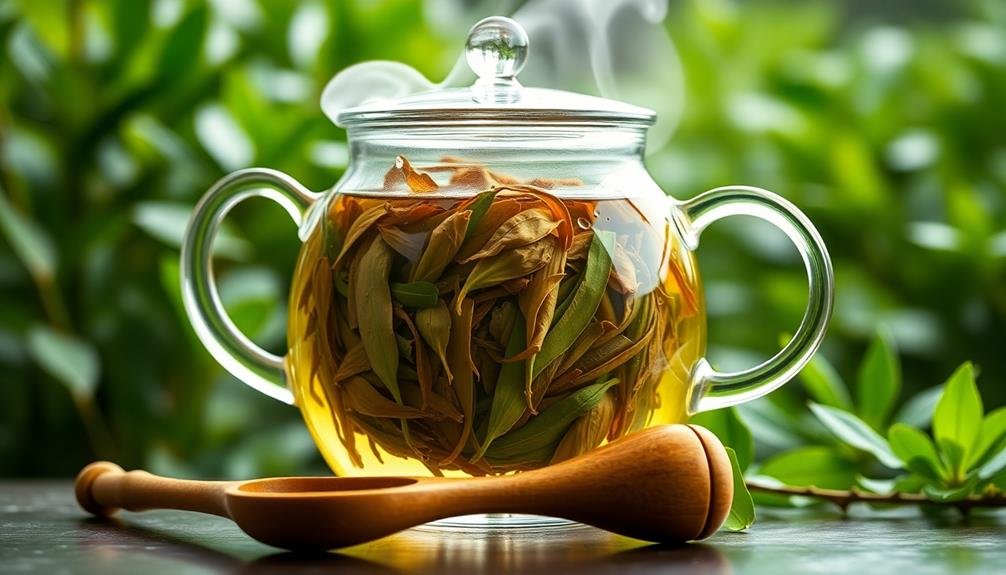
Water conservation goes hand in hand with eco-friendly tea brewing. You can greatly reduce your water usage while still enjoying your favorite loose leaf teas. By implementing simple techniques, you'll not only save water but also enhance your tea's flavor.
To conserve water when brewing tea, consider these methods:
- Use a kettle with water level markings
- Heat only the amount of water you need
- Reuse leftover hot water for cleaning or watering plants
- Collect and repurpose rinse water from tea preparation
Opt for a kettle with precise measurements to avoid overheating excess water. When steeping, use just enough water to cover the leaves, allowing them to expand fully. This technique, known as the "gongfu" method, produces multiple flavorful infusions from a single batch of leaves.
Don't discard leftover hot water; instead, use it for cleaning or let it cool for watering plants.
Collect the water used to rinse your teapot or cups and repurpose it for household tasks. By adopting these water conservation techniques, you'll reduce your environmental impact while savoring your eco-friendly loose leaf tea.
Upcycling Tea Packaging
Eco-conscious tea drinkers can extend their sustainable practices beyond water conservation to packaging reuse. Many loose leaf teas come in attractive tins or containers that you can repurpose once empty. Transform these containers into storage for other teas, spices, or small household items.
Metal tins make excellent planters for succulents or herbs, adding a touch of greenery to your kitchen.
Don't overlook paper packaging either. Tea boxes can be converted into organizers for desk supplies or jewelry. Larger boxes work well for gift wrapping or creating DIY drawer dividers.
If your tea comes in cloth bags, wash and reuse them as produce bags for grocery shopping or sachets for homemade potpourri.
Get creative with tea packaging materials. Use colorful tea wrappers for scrapbooking or decoupage projects. Turn sturdy cardboard containers into pencil holders or small compost bins for kitchen scraps.
By upcycling tea packaging, you'll reduce waste, save money on storage solutions, and add unique, personalized touches to your home decor.
Zero-Waste Tea Accessories

As you explore deeper into eco-friendly tea practices, it's essential to reflect on zero-waste accessories. These items not only enhance your tea experience but also minimize environmental impact. Opt for reusable infusers made from stainless steel or organic cotton, replacing disposable tea bags. Invest in a durable glass or ceramic teapot that'll last for years, reducing the need for frequent replacements.
Consider these zero-waste tea accessories:
- Bamboo tea tray
- Biodegradable tea filters
- Beeswax-coated tea storage containers
- Compostable tea scoops
When selecting accessories, prioritize materials like bamboo, glass, and stainless steel, which are long-lasting and easily recyclable. Avoid plastic components whenever possible.
Look for multi-purpose items, such as a tea infuser that doubles as a cold brew filter. Don't forget about cleaning supplies; use natural bristle brushes and biodegradable sponges to maintain your accessories without introducing harmful chemicals or microplastics into the environment.
Growing Your Own Tea Plants
Taking your eco-friendly tea journey to the next level involves growing your own tea plants. You'll need to start with Camellia sinensis, the plant species used for most teas. Choose a variety suitable for your climate, such as Chinese or Japanese cultivars for cooler regions, or Indian Assam for warmer areas.
Ensure your plants receive partial shade and well-draining, slightly acidic soil. You can grow tea in containers or directly in the ground, but they'll need protection from harsh winds and extreme temperatures.
Water regularly, but don't oversaturate the soil.
Harvest young leaves and buds in spring for the best flavor. You'll need patience, as it takes about three years for a tea plant to mature enough for harvesting.
Process your leaves according to the type of tea you want: green, black, or oolong.
Growing your own tea plants reduces transportation emissions and packaging waste. It also gives you complete control over the cultivation process, ensuring your tea is pesticide-free and truly sustainable.
Plus, you'll gain a deeper appreciation for the art of tea-making.
Eco-Friendly Tea Blending Tips
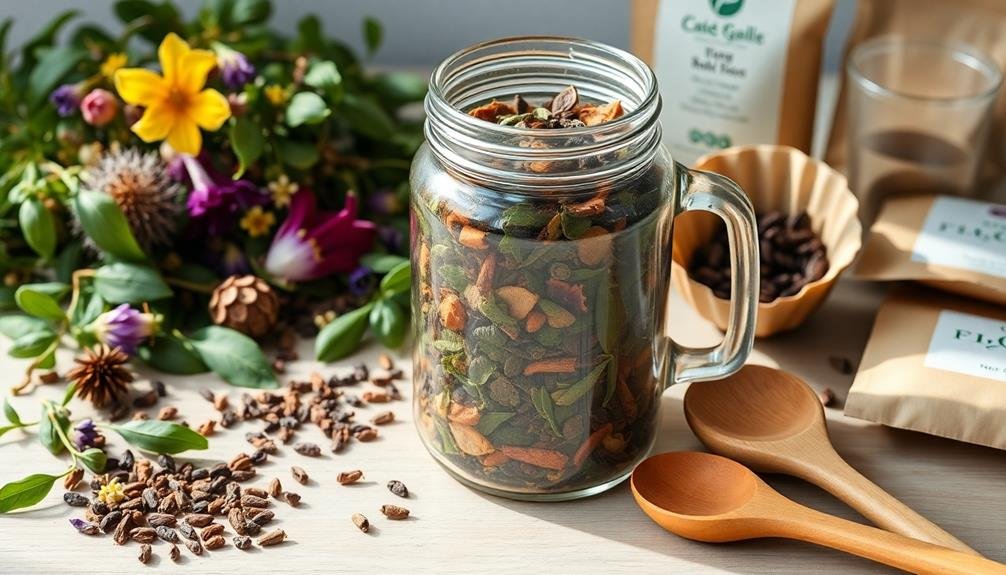
Tea-blending enthusiasts can embrace eco-friendly practices while creating unique flavors. When crafting your own blends, opt for organic, locally sourced ingredients whenever possible. This reduces your carbon footprint and supports sustainable farming practices.
Choose loose leaf teas over bagged varieties to minimize packaging waste and guarantee better quality.
Experiment with eco-friendly additions like dried fruits, herbs, and spices from your garden or local farmers' market. These natural ingredients not only enhance flavor but also reduce reliance on artificial additives.
Store your blends in reusable glass jars or tins to keep them fresh and minimize plastic usage.
Here are four eco-friendly tea blending tips to take into account:
- Use compostable or biodegradable packaging for gifting or selling your blends.
- Incorporate foraged ingredients like wild berries or edible flowers (confirming they're safe for consumption).
- Reuse tea leaves for multiple infusions before composting them.
- Create seasonal blends to take advantage of locally available ingredients throughout the year.
Sustainable Tea Ceremonies
From ancient traditions to modern practices, sustainable tea ceremonies are gaining popularity among eco-conscious tea enthusiasts. You can incorporate eco-friendly elements into your own tea rituals to minimize environmental impact while savoring your favorite brews.
Start by choosing locally sourced, organic loose leaf teas and reusable brewing tools. Opt for a ceramic teapot or a glass infuser instead of disposable tea bags. Use a cloth napkin or bamboo mat as your tea table centerpiece, and serve your guests in handcrafted ceramic cups.
Here's a comparison of traditional and sustainable tea ceremony elements:
| Element | Traditional | Sustainable Alternative |
|---|---|---|
| Tea | Bagged tea | Organic loose leaf tea |
| Infuser | Metal ball | Reusable cloth or bamboo |
| Cups | Disposable | Ceramic or glass |
| Snacks | Packaged | Homemade or local |
| Decor | Fresh flowers | Potted plants |
Consider composting used tea leaves and incorporating mindfulness practices into your ceremony. Focus on the present moment, appreciating the aroma and flavor of your tea while being aware of your environmental impact. By making these small changes, you'll create a more sustainable and meaningful tea experience.
Fair Trade Tea Practices
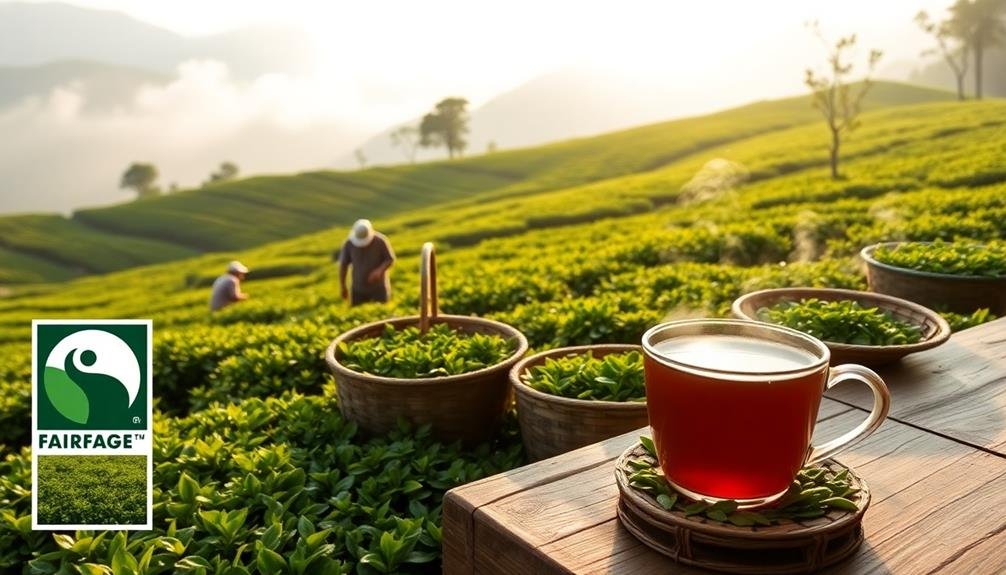
Beyond sustainable tea ceremonies, fair trade practices play an essential role in the eco-friendly tea industry. When you choose fair trade tea, you're supporting a system that guarantees tea farmers receive fair wages and work in safe conditions. This ethical approach extends to the entire supply chain, from cultivation to packaging.
By opting for fair trade loose leaf tea, you're contributing to:
- Better living standards for tea workers
- Sustainable farming practices
- Community development projects
- Environmental protection initiatives
Fair trade certification assures that your tea is produced without exploitative labor practices or harmful chemicals.
You'll often find that these teas are of higher quality, as farmers can focus on producing exceptional leaves rather than cutting corners to meet demand.
Look for fair trade labels when purchasing your loose leaf tea. You'll typically find these teas at specialty shops, health food stores, and online retailers.
While they may cost slightly more, the benefits to workers and the environment far outweigh the price difference.
Frequently Asked Questions
How Long Can Loose Leaf Tea Be Stored Before It Loses Flavor?
You can store loose leaf tea for up to 18 months before it starts losing flavor. Keep it in an airtight container away from light, heat, and moisture. It's best to consume it within 6-12 months for ideal taste.
Can Loose Leaf Tea Be Brewed in a Coffee Maker?
You can brew loose leaf tea in a coffee maker, but it's not ideal. You'll risk over-extraction and a bitter taste. Instead, use a tea infuser or strainer for better flavor control and a more enjoyable cup.
Are There Any Health Risks Associated With Reusing Tea Leaves?
You shouldn't reuse tea leaves more than once or twice. They can harbor bacteria if left damp, potentially causing illness. Additionally, reused leaves have less flavor and fewer beneficial compounds, diminishing your tea's quality and health benefits.
What's the Difference Between Organic and Conventional Loose Leaf Tea?
You'll find organic loose leaf tea is grown without synthetic pesticides or fertilizers, while conventional tea may use these chemicals. Organic tea often has a purer taste and fewer residues, but it's typically more expensive.
How Do Different Water Temperatures Affect the Taste of Loose Leaf Tea?
You'll notice different flavors emerge with varying water temperatures. Hotter water extracts stronger, bolder tastes, while cooler temps bring out subtle notes. Experiment to find your perfect balance for each tea type you're brewing.
In Summary
You've now got the tools to make your tea habit more sustainable. Remember, every small change counts. From choosing eco-friendly sources to composting your leaves, you're making a difference. Don't forget to explore growing your own tea or hosting sustainable ceremonies. As you sip your next cup, you'll know it's not just good for you, but for the planet too. Keep steeping responsibly and enjoy your eco-friendly tea journey!


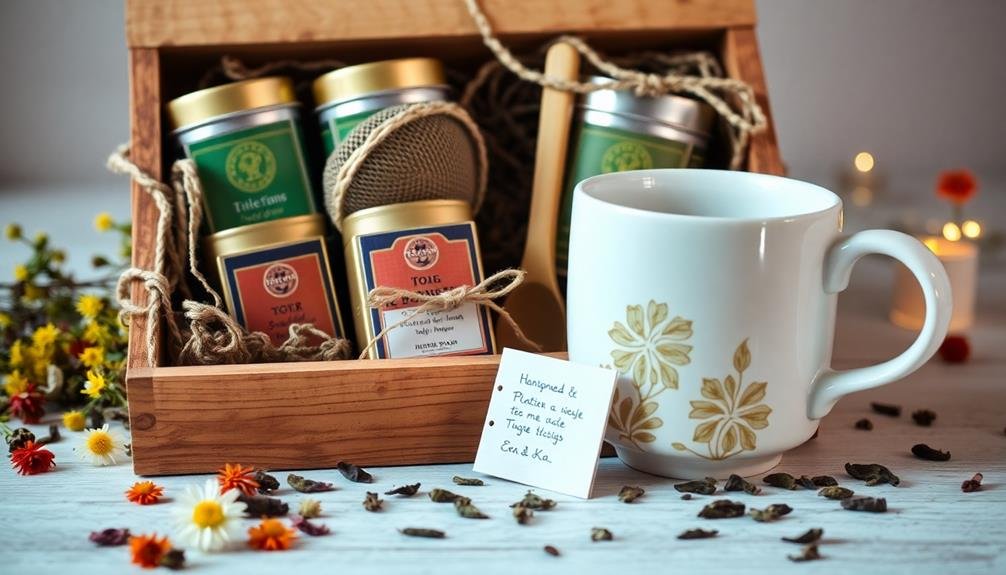

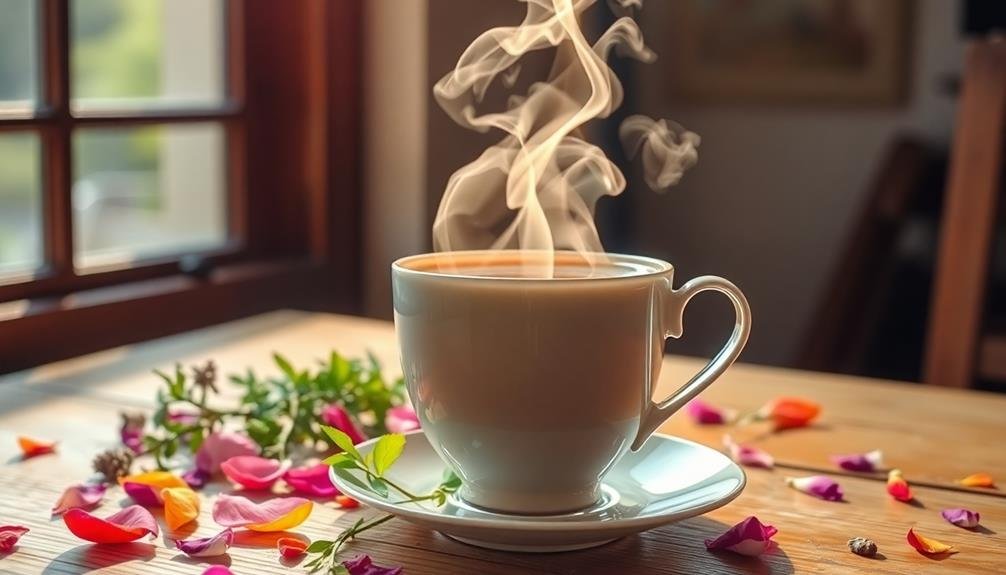
Leave a Reply